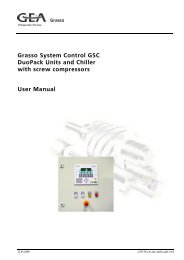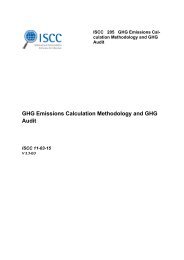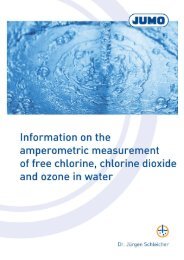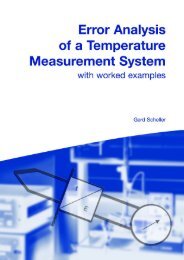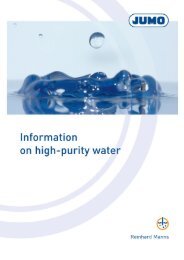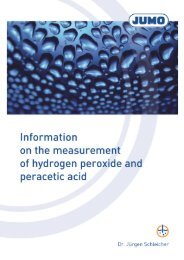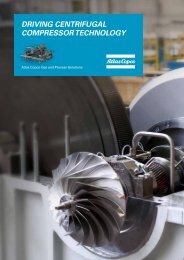FAS622en_pH measurement
You also want an ePaper? Increase the reach of your titles
YUMPU automatically turns print PDFs into web optimized ePapers that Google loves.
4 Applications<br />
4.4 Power stations<br />
In power stations, water is used for steam generation. To avoid dangerous deposits1, the boiler<br />
water must be free from dissolved substances, the only presence permitted is an alkalizing agent<br />
such as ammonia. If the steam is collected and condensed, the condensate can be reused as boiler<br />
feed water. This condensate is almost like distilled water.<br />
Pure water is very aggressive, particularly with a <strong>pH</strong> value below <strong>pH</strong> = 7. Corrosion damage can<br />
easily cost a small fortune. The problem here is that pure water also causes considerable problems<br />
with regard to the <strong>measurement</strong>. Even small impurities can appreciably affect the <strong>pH</strong> value, and taking<br />
a sample for a <strong>measurement</strong> is not really feasible. The <strong>pH</strong> <strong>measurement</strong> must be made in a<br />
through flow.<br />
Measurement setup<br />
Analysis of the vessel water is dealt with in the DVGW (German Gas and Water Association) specifications.<br />
Special <strong>measurement</strong> setups are required for <strong>pH</strong> <strong>measurement</strong>.<br />
Contamination<br />
All components of the <strong>measurement</strong> setup that come into contact with the water, fitting and flowthrough<br />
cell, must be made of VA stainless steel. If plastic components are necessary, these must<br />
not give off any substances into the water. The electrode must contain a neutral electrolyte; a reference<br />
electrode containing silver chloride can react acidically, for example. The ideal arrangement<br />
is a dual electrode system, in which the reference electrode is mounted after the measuring electrode<br />
in the through flow. Because of the relatively high resistance of the water, an electrode with a<br />
low membrane resistance is recommended. The diaphragm should also have the lowest possible<br />
resistance, e.g. an annular diaphragm. With ceramic diaphragms, the resistance increases significantly<br />
as a result of water ingress. The electrolyte solution must be free of silver. The solubility of<br />
the silver chloride is rapidly reduced by contact with the electrolyte solution. Silver chloride deposits,<br />
which are difficult to dissolve, are formed in the diaphragm (the point of contact between the<br />
electrolyte and water).<br />
Boiler water has a conductivity below = 50µS/cm, so that a normal <strong>pH</strong> transmitter is adequate for<br />
the <strong>measurement</strong>. The conductivity in condensate can be below = 1µS/cm. In this case, a transmitter<br />
with a high-impedance input for the reference electrode is recommended. The <strong>measurement</strong><br />
setup must be well grounded, so that electric charges can drain away.<br />
Flow<br />
Every <strong>pH</strong> electrode reacts to the flow of the water. The lower the conductance and the higher the<br />
flow velocity, the more pronounced is this effect. The low conductivities of the boiler feed water<br />
and particularly the condensate can easily change the measured value by several tenths of a <strong>pH</strong><br />
unit and even by up to one <strong>pH</strong> unit. Regulating the rate of flow in the measuring vessel is an effective<br />
measure here.<br />
Alternative methods<br />
As an alternative, it is possible to estimate the <strong>pH</strong> value of the water from the values for the conductivity<br />
or the ammonia content. However, the conductivity value only provides information on the<br />
maximum extent to which the <strong>pH</strong> value can deviate from the neutral point (<strong>pH</strong> = 7). It is impossible<br />
to make a statement on whether the water reacts acidically or basically, purely on the basis of the<br />
conductivity value. Estimates based on the ammonia content can easily result in estimated <strong>pH</strong> values<br />
that are too high.<br />
1 A coating on the boiler walls acts as thermal insulation and increases energy consumption. If part<br />
of the coating cracks, local overheating of the boiler water can occur, and, under certain circumstances,<br />
this can lead to a boiler explosion.<br />
40 4 Applications JUMO, FAS 622, Edition 04.07



